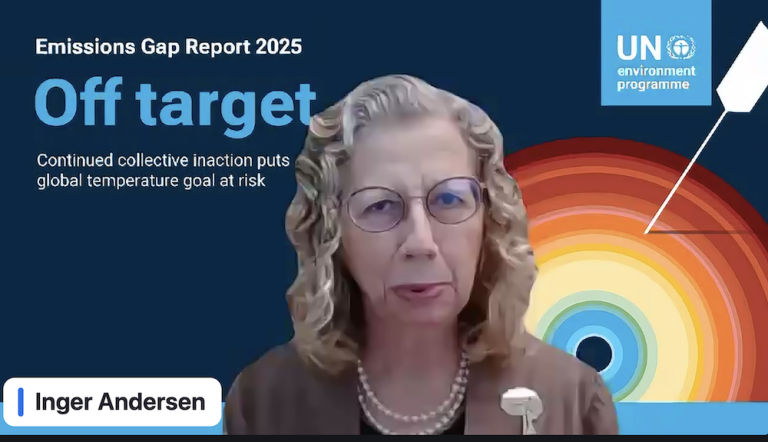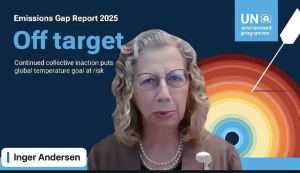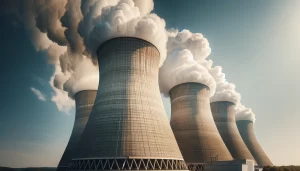Jakarta — The world remains far off course to meet its climate goals, with current national pledges putting Earth on track for 2.3°C of warming by 2035, according to the United Nations Environment Programme’s (UNEP) Emissions Gap Report 2025, launched Tuesday, November 4, under the stark title “Off Target: Continued Collective Inaction Puts Global Temperature Goal at Risk.”
UN Secretary-General António Guterres opened the report launch with an urgent call to action, warning that “a temporary overshoot of about 1.5°C is now inevitable, starting at the latest in the early 2030s.” While acknowledging some progress from last year’s projection of 2.6°C, he stressed that “current commitments still point to climate breakdown” and urged leaders to “step up and speed up” to keep the Paris Agreement’s temperature goals alive.
“The path to a livable future gets steeper by the day. But this is no reason to surrender—it is a reason to step up,” said Guterres, calling for an “immediate peak in global emissions” and a “massive scale-up in renewables and adaptation finance, especially for developing countries.”
Looking ahead to COP30 in Belém, Brazil, Guterres called it a “turning point” where the world must deliver a credible plan to close the ambition and finance gaps. He urged mobilising USD 2.3 trillion annually by 2035 in climate finance for developing nations.
“The window to 1.5°C is narrow but still open,” Guterres concluded. “Let us accelerate to keep that goal alive—for people, for the planet, and for our common future.”
UNEP: Pledges narrow the gap, but only slightly
UNEP Executive Director Inger Andersen said that nearly ten years after the Paris Agreement, countries have missed the mark in each round of Nationally Determined Contributions (NDCs). As of late October 2025, only about one-third of parties had submitted updated pledges.
While new NDCs modestly narrow the emissions gap, Andersen said they remain insufficient: “Global warming projections over this century are now between 2.3 and 2.5°C—still far from the 1.5°C target,” she said. “We need unprecedented cuts in greenhouse gas emissions in an ever-compressing timeframe and amid a challenging geopolitical context.”
Andersen noted that without stronger policies, the world remains on track for 2.8°C of warming under current trajectories. She also warned that the United States’ upcoming withdrawal from the Paris Agreement would offset about 0.1°C of projected temperature improvements.
Record emissions, rising across all sectors
Chief Scientific Editor Anne Olhoff presented the report’s findings, revealing that global greenhouse gas emissions hit a new record of 57.7 gigatons of CO₂-equivalent in 2024, up 2.3 per cent from the previous year. The increase, she said, occurred “across all categories of greenhouse gases and all major sectors,” with fossil fuels accounting for nearly 70 per cent of the total and land-use change driving additional spikes.
Among the G20, updated NDCs could lower 2035 emissions by about 2.8 gigatons of CO₂-equivalent, or 3.6 gigatons if all pledges are fully met. However, this still falls well short of the 35 to 55 per cent reductions needed to align with pathways below 2°C and 1.5°C, respectively.
“Every fraction of a degree avoided matters,” Olhoff said. “The longer we delay, the greater our reliance will be on uncertain, risky, and costly carbon dioxide removal technologies.”
Both Andersen and Olhoff emphasised that a temporary overshoot of 1.5°C is now nearly inevitable, but its magnitude and duration can still be minimised. Limiting this overshoot, they said, requires cutting emissions by 26 per cent by 2030 and 46 per cent by 2035, along with scaling up carbon removal.
The report also highlights reasons for hope, with renewables surpassing coal as the largest source of electricity globally in the first half of 2025 and costs continuing to fall. Methane mitigation efforts are expanding, and net-zero pledges now cover roughly 70 per cent of global emissions. (nsh)
Banner photo: UNEP Executive Director Inger Andersen. Source: UNEP webcast screenshot.















